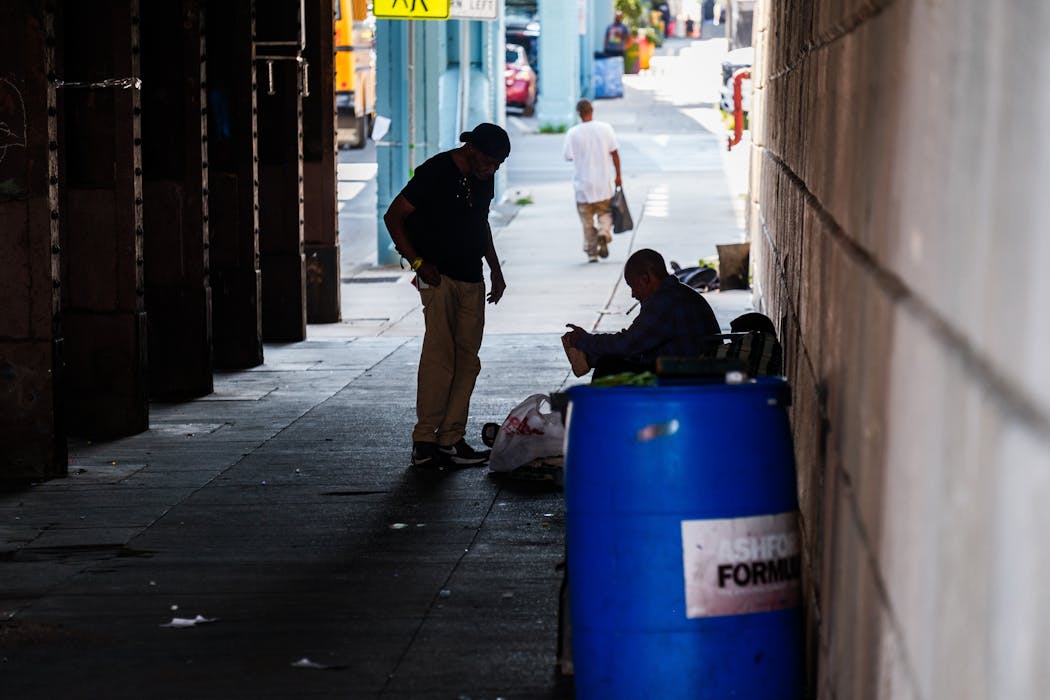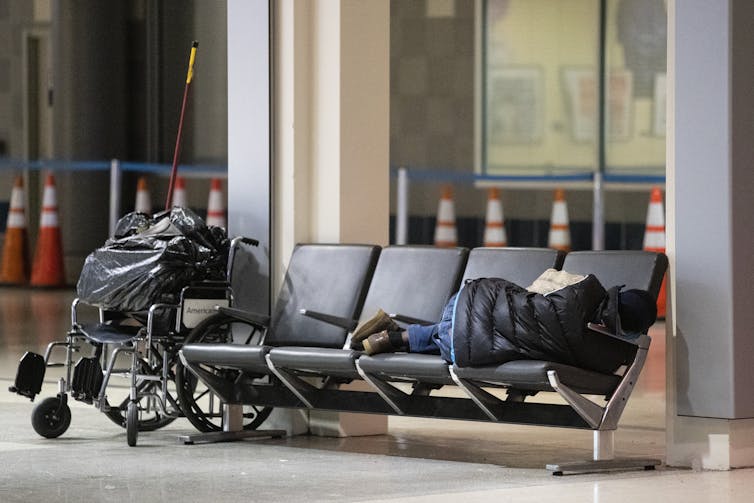Automated systems decide which homeless Philadelphians get housing and who stays on the street – oft
Supportive housing combines subsidies with wraparound social services to help people stay off the streets. But demand far outstrips supply in Philadelphia.

Seeing a person huddled under a makeshift roof of tarps or curled up on a warm grate can evoke powerful emotions and questions.
How did they get here? Why doesn’t someone help them? What can I do about this?
The answers to these questions are complex. However, a significant body of research suggests that there is a highly effective solution for many individuals who experience homelessness. It is called supportive housing.
Supportive housing programs combine a housing subsidy – financial assistance that helps make housing affordable even for those with very low incomes – with wraparound supportive services that help a person remain stably housed. Supportive services often include case management, occupational therapy and mental health and addiction treatment. These programs have helped thousands of Philadelphians end their experiences of homelessness.
As a researcher and former social worker, I have spent much of the past decade working in and studying homeless services in Philadelphia. For my dissertation research, I conducted hundreds of hours of ethnographic fieldwork at a soup kitchen and outreach center in the city between 2022 and 2024. I interviewed 75 homeless services workers, volunteers and people who were experiencing or had experienced homelessness. I also analyzed hundreds of pages of policy documents.
I have found that while the city has succeeded in centralizing services to support unhoused people, there remain major bureaucratic challenges exacerbated by insufficient funding and a shortage of supportive housing. These challenges impact both people seeking supportive housing and front-line workers trying to help them.
Khalil’s story
Consider the case of Khalil, a 48-year-old from West Philly who became homeless during the pandemic. (As for all the interviewees’ names used in this article, Khalil is a pseudonym I’m using to protect his privacy.) Khalil told me that he lost his job as an IT technician at Verizon, where he had worked for nine years. Sleeping outside and unable to afford life-sustaining kidney medication, he said, his physical and mental health spiraled.
A supportive housing program changed that, providing him with a stable and affordable place to live, while social workers helped him enroll in Medicaid and connect with a community health clinic. This support, Khalil explained, allowed him to “transition back into residential living and back into employment and back into being a working member of society.”
Despite the efficacy of supportive housing, cities do not receive sufficient federal funding to provide this service to all residents who are eligible. As a result, the need for these housing programs vastly outstrips the supply.
So how do officials in Philadelphia decide who will continue to sleep on the street or in a shelter, and who can move into a supportive housing facility with a warm bed and access to valuable wraparound services?
How the city determines who gets housing
Like other localities, Philadelphia uses a Coordinated Entry System. CES is a form of automated bureaucracy that combines several different algorithms and administrative processes with the goal of helping officials and social service workers allocate resources fairly and efficiently.
CES is intended to help workers identify which people experiencing homelessness are in greatest need of aid. These systems work by combining a central pool of resources like housing programs and a central list of people seeking help. Unhoused people are scored using a vulnerability assessment tool, and those that score highest are matched to an opening in a supportive housing program.
Because most of these systems are premised on targeting resources to the most vulnerable people, defining and gauging vulnerability becomes fraught with tension. After all, vulnerability is inherently subjective, and there is no universally agreed-upon best way to measure it.
These systems will soon come under even greater pressure as the U.S. Department of Housing and Urban Development prepares to slash funding for supportive housing programs. As many as 170,000 people nationwide who were previously homeless will be at risk of returning to the streets once these funding changes are implemented.
CES has benefits and drawbacks
Coordinated entry has made real progress on several long-standing challenges for Philadelphia’s homeless services system. Chief among these is centralization.
Most resources available for people experiencing homelessness are administered by nonprofit social services organizations. Prior to CES, a person seeking assistance would separately apply to various nonprofits and put their name on multiple waiting lists.
CES centralizes resources into a common pool, accessed through the vulnerability assessment process. As one administrator with the city’s Office of Homeless Services told me, this arrangement is “immensely more supportive and fair” than the scattered process that came before. For example, individual nonprofit providers are less able to earmark resources for clients they already work with.
However, there are downsides to Philadelphia’s approach to CES.
Vulnerability assessments, like those used in Philadelphia, have been criticized for failing to capture a full picture of a person’s plight. Assessments involve asking unhoused people a series of yes or no questions about their housing, health and financial history, and generate a vulnerability score based on the responses. A person who has a relatively mild experience with several different risk factors can end up with a much higher score than a person with an extremely serious experience with just a few.
And similar to other automated assessments, such as in the criminal legal system, they have the potential to introduce racial bias into allocation outcomes.
Furthermore, the way CES works is, by design, hidden from the people it impacts most. The ambiguity is intended to prevent people from gaming the system, but it also creates confusion for those living in shelters and on the street. Some seeking aid may hide evidence of their vulnerability, such as addiction, out of fear it will disqualify them from housing. Others may amplify their vulnerability in an effort to improve their odds of receiving help.
The result is a perception among people experiencing homelessness that the system is unfair.
As Andre, a 60-year-old who had been sleeping in shelters off and on for nearly a decade, told me, a person who “goes in there and tells the absolute truth, they’re put on the back burner.”

‘You’ve got to have a record of being homeless’
Leon, a 25-year-old from North Philadelphia, told me as we chatted over coffee that in order to be prioritized through CES, “You’ve got to have a record of being homeless.”
But generating such a paper trail can be difficult. A city database tracks shelter stays that can serve as proof of homelessness, but not all shelters participate. And for those sleeping outside, like Leon, proof depends on regular interactions with outreach workers, which requires being in the right place at the right time.
If an unhoused person cannot prove the length of their time on the street, or provide documentation of a mental health diagnosis, they may be deprioritized through CES, even if they are highly vulnerable.
For all its advantages, CES in Philly is not designed to take into account the input of unhoused people themselves. In the words of Richie, a 32-year-old who was seeking housing for himself and his pregnant wife, “There is no voice for homeless people … because homeless people don’t have a voice.”
Despite these challenges, the city has lowered barriers to participating in CES. For example, the city has launched a pilot program involving mobile assessors who can complete assessments in different locations beyond city shelters, such as at soup kitchens, to meet unhoused people where they are.
3 ways to improve the system
Here are three concrete ways the city could reduce more of the bureaucratic hurdles to supportive housing.
First, the city could expand pathways to supportive housing through a model called multiprinciple allocation. This approach combines different methods for determining who gets housing. Some subsidies could be allocated through new vulnerability assessments that are better vetted for bias, while others are distributed based on length of homelessness or a lottery system. This could bolster fairness by ensuring that people whose vulnerability is not picked up through the assessment tool could still have a shot at aid.
Second, the city could provide opportunities for unhoused people and front-line workers to attest to vulnerability and experiences of homelessness in their own words – allowing someone to say, “I am struggling with housing for reasons that the assessment did not cover.”
And third, Philadelphia could reduce the degree of automation in the CES matching process. As things stand, people with high scores are mechanically matched to open programs, even if that program is a poor fit for the individual person. Giving staff and unhoused people more agency in making housing matches could produce better outcomes.
No amount of tinkering with CES can address the fundamental resource constraints that shape the fight against homelessness in Philadelphia. Simply put, Philadelphia lacks sufficient funding for housing the most vulnerable. But thoughtful changes to CES could make the response to homelessness more effective, compassionate and fair.
Read more of our stories about Philadelphia, or sign up for our Philadelphia newsletter on Substack.
Pelle G. Tracey has received funding from the Google Award for Inclusion Research.
Read These Next
Getting peace right: Why justice needs to be baked into ceasefire agreements – including Ukraine’s
Just war theory, a centuries-old field of ethics, deals with how and when to start conflicts. It can…
From civil disobedience to networked whistleblowing: What national security truth-tellers reveal in
Whistleblowers’ stories show how accountability is shifting from formal legal institutions to solidarity…
2025’s extreme weather had the jet stream’s fingerprints all over it, from flash floods to hurricane
The US had a rare year without a hurricane make landfall, but it saw too much extreme rainfall and flash…





